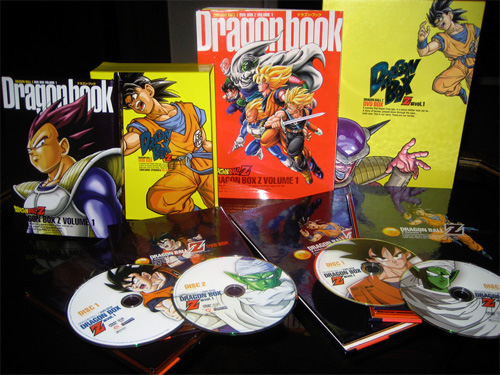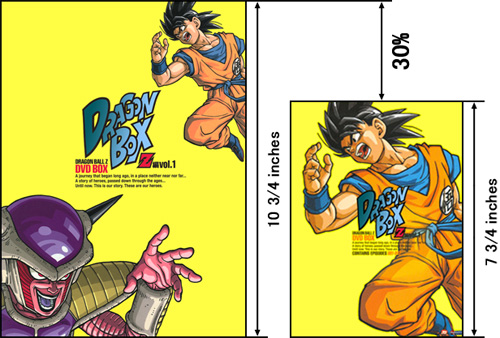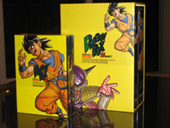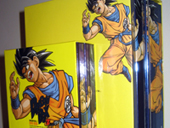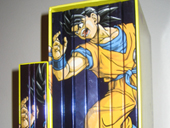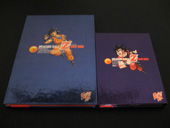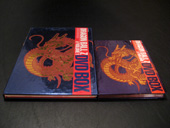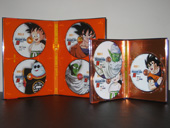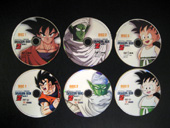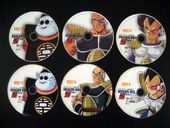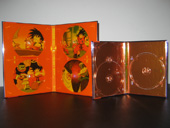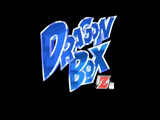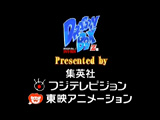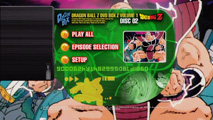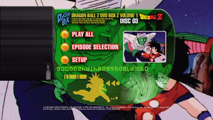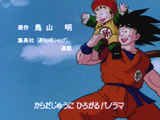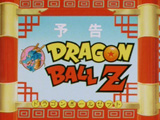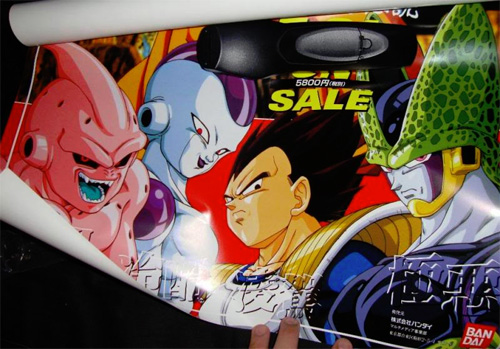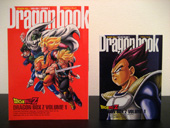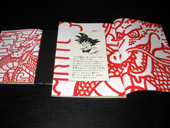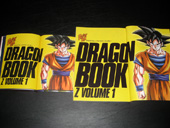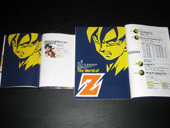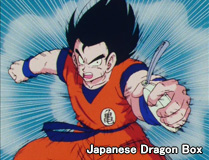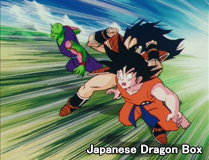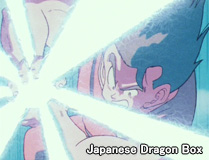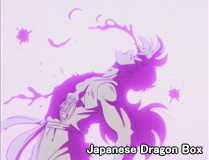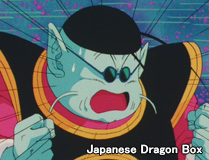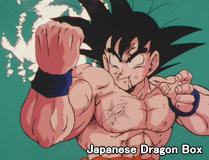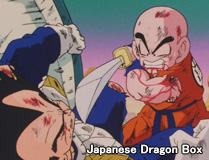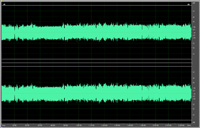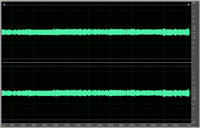The general history of Dragon Ball Z in the United States is a long, storied, and overly complicated one. The DVD releases alone are so complex that it is hard for even avid fans to keep track of them all, let alone a casual fan. We have seen both censored and uncensored releases, multiple distributors, multiple voice casts, varying music in each release, varying scripts, canceled releases, and much more. Overall there have been three releases and somewhere amongst them all, you could piece together some sort of a coherent release — you can probably understand what an enormous feat it truly is to see FUNimation releasing a (to use their own phrase) “reversioning” of the Japanese “Dragon Boxes”. In fact, this reversioning is directed almost entirely toward fans of the original Japanese series, rather than the English dub.
It was 17 November 2009 that the first volume of FUNimation’s domestic Dragon Boxes was released. Fans scrambled to get their hands on it, but many wondered what the differences were between the two releases, as most fans do not have access to the expensive, original Japanese versions. Fear not, because this feature will give you a thorough comparison of the two releases! (At least the first volume, anyway.)
For additional thoughts and information, please listen Episode #0198 of our podcast. We also have the more formal review as originally published on Daizenshuu EX. If you would like more information concerning the original Japanese Dragon Box releases, please check out our “Home Video Guide“.
On to the feature!
Box Design
As originally announced, FUNimation’s domestic Dragon Boxes would be smaller in not only its physical size but the number of discs each volume would contain, as they are going to be splitting the original two volumes into seven separate volumes. In terms of a size difference, the domestic Dragon Boxes are about 70% of the height and width of the original Dragon Boxes, or rather, 30% smaller. Obviously since they are being split up, the thickness of the individual domestic volumes are much smaller than the originals.
If that comparison does not do it for you, here are some photos of the two boxes side-by-side. Having the two on a shelf next to each other is kind of weird, as the original completely dwarfs FUNimation’s Dragon Box. However, if you do not own the original Dragon Box, then this does not really concern you — it just seemed worth noting. While on the subject, it should be noted that this was actually a great move on FUNimation’s part. We take our hat off to them when it comes to making smart business decisions, because the most likely reason they shrunk down the domestic Dragon Box was for retail reasons. It is a lot easier to have a retailer put a regular sized DVD box on a shelf than a huge oversized one, and overall it increases the chances someone will actually buy it. I would argue that since the original Dragon Box was a pre-order collectible only and was never shipped to retailers, its size was never really an issue (except when you actually try to put it on your regular DVD shelf), but since FUNimation is making this available to everyone, it stands to reason that they would want it to fit easily on a retailers shelf so you will buy it, as I did.
Overall, the domestic Dragon Boxes packaging is nearly the same as the original, with some minor alterations here and there. The way the box was constructed is slightly different, and for some people it has caused parts of the yellow paper around the box to peal off (mine included). However, some glue fixes that right up, although I never should have had to to do it in first place. And if you’re wondering, I never had this problem with the original. Now more importantly, most of the text has been left as-is, even some kanji, although FUNimation has added some of their own. Here’s a run-down of some of the differences between the two Dragon Boxes.
- The biggest thing that stands out is that Freeza has been removed and Goku now takes up the entire front of the box.
- The spine of the Dragon Box now has the one-star-ball and lists the episodes contained in this volume. This is where we find the kanji that FUNimation has added, which is simply Japanese for 1-42. I’m not sure why they added these besides the fact they are really trying to drive home the fact that the Dragon Ball series are “now” indeed from Japan.
- All FUNimation and Toei logos have been added.
- The back of the box is nearly identical to the original, which is nice to see. The only real additions to the back are an episode count and additional copyright information. Speaking of, there is actually something a little strange about the copyright information. On the original, only the four main property holders are listed; Bird Studio, Shueisha, Fuji TV, and Toei Animation. On FUNimation’s, they have these listed as well, along with some additional U.S. copyright information. Oddly enough, they only list Dragon Ball Z and Dragon Ball GT, but completely leave out Dragon Ball. I do not know if this means anything, but I find it odd since they usually list all three series on their products. Incidentally, this same issue occurs on both the DVD books and discs.
DVD Books/Discs
One thing that stood out to me right away is the difference in color between the two DVD books, which becomes blatantly obvious when you put the two releases next to each other. The domestic DVD books appear to be more purple in color and much shinier, while the originals are more of a blue and the outer gloss has more of a mat finish. Unfortunately, this new gloss finish on the domestic Dragon Box picks up finger prints quite easily, which is rather annoying. Another noticeable difference is the image change. The image of Goku on the front of the DVD books has been changed on the domestic Dragon Box to match that shown on the back of the Dragon Book. This image of Goku is an old promotional image used by FUNimation on a variety of products, most notably on the title screen of the Game Boy Advance video game The Legacy of Goku. It is not clear why FUNimation decided to change this image, especially when they easily could have just used the same Goku image that appears on the front of the box like the original did. However, the back of the DVD books were left as-is, which again really makes the changes to the front questionable.
In addition to DVD book image changes noted above, most of the images on the discs have been changed. The only ones that remained the same as the originals were Discs 3 & 4 which show Son Gohan and Kaiō-sama. You will note that since the total number of discs has been cut down in the domestic release, some of the original disc art will be omitted. In this set, the disc feature Bulma has been omitted although the same number of episodes were covered. It will be interesting to see what disc art gets left out over the course of this domestic release. While on the subject of omitted images, we may as well discuss the images behind the discs. In the original DVD books there was a screenshot placed beneath each disc from an episode on that specific disc, displaying a character from the corresponding disc art. However, in the domestic DVD books you will only find a number beneath the disc corresponding to that disc. Although I do not like this, I can understand why they probably did it. Since two of the discs in each DVD book overlap, they would have had some issues with placing screen shots behind them. Rather than make it look horrible, they simply omitted them altogether.
As noted above, FUNimation is splitting the original Dragon Boxes into seven separate volumes. Due to this, each volume will come with two DVD books. If you do the math, that will bring us to 14 DVD books in total, which is the same as the original Dragon Box. Each DVD book contains three discs with seven episodes per disc. You will note that this is different from the original, where each DVD book contained four discs with six episodes per disc. This was possible because the DVD books themselves were so tall. In the smaller domestic Dragon Box there is not enough room to allow for this, and so some of the discs have to be overlapped in order for them to fit in the smaller packaging. If they had gone with four discs in each DVD book, then both sides of the DVD books would have had overlapping discs. This would result in an overall thicker DVD book which would not only make each volume thicker, but also possibly screw up the spine art. Although the discs are stored differently, it is interesting that the total thickness of the domestic Dragon Boxes’ two DVD books ending up being the same thickness as two DVD books from the original.
Another obvious change was that the spine art featured on the DVD books was adjusted on the domestic Dragon Box. This was most likely due to the change of height between the two releases, as well as the slight change in overall thickness of the sets. By that I mean if you took all seven domestic Dragon Boxes and set them next to each other in a row on your shelf, they would take up more space width-wise than if you had the two original Dragon Boxes combined. Therefore, rather than shrink the spine art vertically, they cropped off the bottom and stretched it out to accommodate for this difference in the overall combined thickness. In fact, they have actually adjusted the spine art down a little giving us more of Goku’s head/hair on the domestic Dragon Box, which is a little odd since they had already cropped the spine art.
When you pop the domestic discs into your DVD player, you will notice they start out with trailers for various anime properties and jump straight to the menus. Is something missing? FUNimation has omitted the original Dragon Box intro animation! While it is not that big of a deal, it still would have been nice to see this. I mean, this is the Dragon Box, right? Also, as I mentioned, after all of the introduction material the domestic Dragon Box jumps straight to the main disc menu, while on the original it goes straight into the “All Play” selection and starts showing the first episode on the disc. Again, it is not a huge deal, and in all honestly I think I like the way FUNimation did it better.
Of everything so far, I would say the disc menus are by far the one aspect that has been changed the most. While the disc menus are based on the original Dragon Box menus, FUNimation has completely redrawn them for the domestic release. Not only that, but FUNimation has made all of the menus anamorphic widescreen. The domestic Dragon Box menus are also static with Japanese background music playing, while the original menus had actual scenes (Goku vs. Vegeta / Goku vs. Freeza) playing along with the corresponding scenes audio in the background and on the scouter. However, although the menus are static, FUNimation did add some variety to them. The main background of each disc changes, along with its episode selection menus, whereas on the original the background animation never changed, except between the two volumes.
You will notice right away that one key option is missing on the domestic Dragon Box. That is right, there is no “Story Mode” option, or as FUNimation called it on their Season Sets, the “Marathon” feature. It is a real shame they got rid of this, but they did replace it with a “Setup” option to select the language and subtitle tracks. The setup menu uses the same Shenron background as was found on the original Dragon Box Z Vol. 1 special disc. The layout of the main disc menu is also a tad different. For instance, FUNimation added a yellowed character outline in the lower left-hand corner of the scouter and an image of Goku punching Vegeta in the lower right-hand corner. The gibberish text that appears on the scouter has also been changed and now starts with “9000”. I wonder why?

So what exactly are you getting for your money, and what sets this release apart from the others? The answer is quite simple, and it is that with this box set you are truly getting the purest presentation of Dragon Ball Z possible. Presented here are the full episodes from start to finish, as they aired on TV almost two decades ago (and counting). This includes the complete opening credits, ending credits, and next episode previews, which are not available outside of the Dragon Box release.
Disc Contents
You may be curious what volumes will contain what episodes. So, here’s an estimate of what episodes each volume will contain based on the current information available. It will be updated as additional volumes are announced.
| Dragon Box | Episodes | Release Date |
| Volume 1 / Discs 01 – 06 | 001 – 042 | 17 November 2009 |
| Volume 2 / Discs 07 – 12 | 043 – 084 | 16 February 2010 |
| Volume 3 / Discs 13 – 18 | 085 – 126 | 04 May 2010 |
| Volume 4 / Discs 19 – 24 | 127 – 168 | 21 September 2010 |
| Volume 5 / Discs 25 – 30 | 169 – 210 | 26 April 2011 |
| Volume 6 / Discs 31 – 36 | 211 – 252 | 19 July 2011 |
| Volume 7 / Discs 37 – 42 | 253 – 291 | 13 September 2011 |
Based on this breakdown, the 6th disc (42 overall) of Dragon Box Vol. 7 will contain only 4 episodes leaving the possibility for some extras. However, it is uncertain at this time exactly which extras these might be. Possible extras include both TV specials, non-credit opening and endings, product advertisements, foreign dub clips, Playdia side story footage, and raw archival footage of the original 16mm film before remastering.
Dragon Book
The domestic Dragon Book is roughly 25% smaller than the original, which was about the same size as a daizenshuu guide book. Most obviously, the images on the covers were changed. The image of Vegeta on the front cover is taken from the PlayStation and Sega Saturn video game Idainaru Doragon Bōru Densetsu (photo courtesy of Tanooki Kuribo), although it has been redrawn:
As mentioned earlier, the image of Goku on the back cover is an old promotional image used by FUNimation on a variety of products, and is also used on the DVD books. Overall, it appears that roughly the same layout was kept, as-in how the individual pages are organized. Oh, and the book is read from right to left like traditional manga. Besides the difference in size, the biggest difference is that the domestic Dragon Book has a hardcover, while the original has a softcover. In addition, the page count has been reduced to allow the two original Dragon Books to be split up over 7 volumes. The original Dragon Books had 128 pages each, while FUNimation’s has 48 pages.
As expected, the domestic Dragon Book is somewhat of a “literal” translation of parts of the original Japanese Dragon Book. By that, I mean the way certain things are phrased are taken straight from the original, such as “Profile of Goku Family”, which is basically Engrish. Actually, you will find that there is quite a bit of odd phrasing used throughout the book. Although Steve Simmons is credited as the only translator, this is not typical of his normal work. Some of the inconsistencies make it really seem like there were multiple people translating, but we cannot be certain and have to assume Steve Simmons translated it solo. Although, it also could stand to reason that Steve translated everything correctly, but certain things were later edited without his consultation. You just never know with FUNimation.
One aspect that was a shock to see was the naming conventions. There are no signs of any dub names or dub episode titles in this release, both in the Dragon Book and the episodes themselves. They have all been translated correctly, although in some cases the names have been changed from a “correct” dub name to a simple romanization of the name which I do not think was all that necessary. For instance, Yamcha, which is a perfectly acceptable translation of the characters name used in the dub, has been changed to “Yamucha” which is an exact romanization of how the characters name is written in Japanese. Yet at the same time they leave Bulma’s name as-is, even though by the previous logic they probably should have gone with “Buruma” just as they changed “Krillin” to the proper “Kuririn”. It just seems that even though they have corrected a lot of the names, they did not do it too consistently. However, it is nice to see Kaiō-sama, Uranai Baba, Gyū-maō, Tenshinhan, etc. written with their Japanese names. Are these small nit-picks? Yeah, but I think it is worth noting and it does not really take anything away from how much of an improvement this is over the previously used dub names (Tien, anyone?).
Dragon Book Contents
Before we get too far into it, I would like to note that compared to the original a lot of the screen shots used in the domestic Dragon Book are darker and not quite as crisp. It very well may be a difference in printing quality, as the paper quality is fairly similar. So now let us take a look at what was included in Dragon Book Vol. 1, along with some notes that I felt were interesting.
- This section was only two pages in the original Dragon Book as opposed to four, but I am guessing because the domestic Dragon Book is smaller than the original it was expanded.
- The same screen shots were used, except for Goku punching Yamcha has been replaced with Goku and Yamcha punching at each other.
- The events in FUNimation’s Dragon Book are out of order… well, sort of. Each image has one of the seven Dragon Balls next to it, with the number of stars denoting in what sequential order the events occurred. The events are supposed to follow the path of the yellow line shown in the background, but in FUNimation’s they do not follow the line at all. I am guessing this was done since the section was expanded to four pages, so instead the envents are placed in order per page. Why include the yellow line in the background, then?
- For some reason, they leave Son Goku’s name written in kanji on the first page of the section. The interesting part is they actually translated it in the table of contents as “Goku’s Early Days”, even though the kanji is for his entire name, “Son Goku”, meaning the section title should actually be “Son Goku’s Early Days”.
- As mentioned before, the title of this section was left exactly the same as it was in the original Dragon Book. I am not sure why they did not make Goku’s name possessive in this case so it makes more sense in English. In all honesty, I think “Profile of Goku’s Family” or “Goku’s Family Profile” would have worked much better.
- Both the original and domestic Dragon Books have a “Z” in the middle of the page, and inside the Z are images of the characters highlighted on that page, aligned right next to their respective profile. In the domestic Dragon Book they switched Goku and Piccolo’s images in the “Z”, while they properly matched Gohan and Kuririn’s. It is not that big of a deal, but again, why switch them?
- The actual character profile images themselves have been completely changed.
- There were originally 16 of the main character highlighted in this section, but now there are only four (Goku, Piccolo, Gohan, and Kuririn). I think we can expect these additional character profiles in later volumes.
- It appears the biographies are straight-up translation of the originals and no dub terms are used, which is nice to see for once.
- The chart has been shrunk down and the only characters included are featured in the first 42 episodes. It is assumed all of the omitted characters will be included in later volumes.
- The bottom part of this section was renamed, which is odd since they left “Profile of Goku Family” as-is. In the original its title was “Character Correlation”, but in the domestic it is now “Character Relationships”.
- Some people might think they made a mistake by calling Enma-Daiō the “Great King Yama”, but actually, it is a literal translation. For anyone that is familiar with the English dub, they named him King Yemma, which was somewhat close. Enma-Daiō is based off of Yama, a wrathful Hindu and Buddhist deity who judges the dead. Enma is the Japanese name for “Yama”, while Daiō simply means “Great King”; hence the “Great King Yama”. I know this is how Steve Simmons has translated it before, so this alteration makes sense.
- As done in the original, the section starts with a breakdown of the various story arcs, or as FUNimation calls them, sagas. In this section FUNimation uses “Vegeta Saga” for episodes 1-35, but later on in the Dragon Ball Z Design Works Collection they use “Saiyan Saga”, which is a tad inconsistent, especially considering the original uses “Saiyan Arc”, or saga if you prefer that.
- The way the episodes are listed in the section has been somewhat changed to account for the fact that there are now seven episodes per disc rather than six. What was listed on two pages in the original is now spread across four pages.
- The only information provided for each episode is an episode title (literal translations; no dub titles), a short synopsis, and the original airdate. In the original they also listed credits for the episode director, script writer, animation supervisor, and art supervisor. Apparently we do not care about these things in the U.S., they were just too lazy to want to translate them, or ran out of room.
- It looks like they did translate some of the “Close-Up!!” stuff, which takes a detailed look at a certain person or aspect related to specific episodes. Interestingly, in the Saibaimen close-up they are called Saibamen (note the lack of the final “I”), which is what the dub originally called them. Later on, just a couple pages away, they are correctly called Saibaimen. “Saibai” is actually the Japanese word for “cultivation”, so “Saibaman” is simply incorrect, and not just an alternate spelling.
- In the episode five synopsis, Raditz’s name is misspelled as “Radtiz”. Again, how is some of this stuff getting through quality control?
- The domestic Dragon Book only covers the “Saiyan Saga”, or the first two pages from this section in the original.
- I think this goes without saying, but the images are exactly the same. I do not think people would be too happy if they had changed them since they are Toei’s original character design sketches. The only real difference is that the images are more spread out in the domestic Dragon Book due to the books smaller size.
- It covers all of the events up through episode 42 and has been flipped so that it runs vertical rather than being horizontal like in the original, which makes sense since we don’t typically write things vertically in English.
- Since the timeline only covers as far as the respective episodes on the set, I anticipate we will be seeing these in every Dragon Book from here on out.
- Some of the images included in the notes for certain events have been omitted, most likely due to copyright issues. Speaking of, you will notice on page 29 all of the listed copyright information for all the other various series listed.
- Not much to note except they only covered the clothing styles up through episode 42… but I mean, it is fashion… and the same pictures were used. What else do you need to know?
When compared to the original, you can see that there are still tons of things missing, and that is just from the first Z Dragon Box. They still have a whole second volume to use. With the remaining six domestic Dragon Books, it will be interesting to see how they cram everything else in. There are still 16 Dragon Columns, four interviews, tons more design sketches, another correlation chart, a regular staff file, a look at other countries that dub Dragon Ball Z, tons of special indexes, a look at all the filler in the series, a look at the series TV ratings, lyrics to all the opening and ending themes, and info on the TV specials that have been left out.
Audio/Video Quality
Now that we have exhausted our comparison of the overall packaging, let us take a look at this set’s main draw: the superb audio and video. Why should you care about the video quality? For starters, this is the best video quality that we will likely ever see from FUNimation on a Dragon Ball release. From the very beginning, FUNimation has only ever had generational copies of a master tape, which were never of the best quality to begin with. For the original Dragon Box, Toei Animation actually pulled the original 16mm film reels out of cold storage and used them as the primary source material. All previously-released Dragon Ball content (even the original Fuji TV airings) were based off either the master tapes (copies of the 16mm film), or copies of the masters. Since the 16mm film is actually the original photography of the animation cels, what you are seeing when viewing these discs is essentially the original cel animation, or as close as we are going to get to it.
Since the original Dragon Box used the original cel photography as its source material, the picture is already as pristine as it will ever be. However, as with any film, it is bound to suffer some damage. Pony Canyon took the time to carefully remove all damage from the film, presenting us with a perfectly clean picture, yet never compromising the integrity of the actual animation. On top of this, since they had gone back to the 16mm films, they created an all-new frame alignment. They did not stop there. When making the original masters for a series, it is typical to copy the film while slightly zoomed-in to reduce the risk of catching the edge of a misaligned cel (ie. seeing the edge of the image). However, with time, money, and new digital technology on their side, Pony Canyon created an all new print that captures more image than the original masters. In some cases this actually meant re-aligning some of the frames, which not only allowed for a larger image surface, but also greatly reduced all former traces of jitter. This truly was a frame by frame remastering of the series, and it looks gorgeous!
As with the video, Toei Animation and Pony Canyon went straight to the source material for the audio. Unfortunately, since the series was recorded in mono, it will always have that dated feel to it, but the audio presented here is of very good quality, all things considered. The audio never gives out or cracks during high notes in a song or loud screams, and the typical background noise (that horrible “shhhhhhh” sound) is virtually nonexistent. Also, the opening and ending themes, although remaining in their broadcast mono forms, have been greatly improved and sound very close to stereo quality.
Now FUNimation has this footage in their hands, something that no one ever thought they would get. How does the domestic Dragon Box transfer stand up to the original? Be sure to hover your mouse over the lossey screen shot comparisons below to see the slight differences between the two releases. However, you can also click on them to view a lossless comparison of the same screen shot.
Video Comparison
When FUNimation first announced these sets, aside from a great sense of shock and anticipation, many worried that 42 episodes being fit onto six discs (seven episodes per disc) would cause degradation in video quality. This is because, in addition to their mixed track record with DVD encodes, they would be including more episodes per disc and adding at least one additional audio track not present on the original Dragon Box discs. With the final product in our hands however, most of these concerns can be put to rest.
Those who have seen the original Japanese releases will notice that the FUNimation set is brighter. While FUNimation has a history of making adjustments to various aspects of their releases before, such as brightness, contrast, color saturation, and sharpness, it appears that this change is actually due to differences in the NTSC standards for North America and Japan. In North America, the “black” reference level is slightly higher than that which is used in Japan, which would explain why the Japanese Dragon Boxes are slightly darker than the domestic release. The corollary impact of this is that there is a slight change in the colors. However, this is not something I would personally note as a negative aspect. Some may even view this as a positive, given that the slight change in colors somewhat tames the redder flesh tones that people have cited as a point of contention in the fandom.
Colors are presented with absolute fidelity to the original Japanese releases, barring the slight changes due to the aforementioned shift in brightness. Some slight changes have been made with regards to framing (and will most likely not be seen even by owners of both sets if any degree of overscan comes into play), however this could be attributed to the masters that FUNimation received. Possibly the only aspect that could be seen as an actual downgrade from the Japanese version is that FUNimation’s discs seem to be softer than their Toei counterparts. This does not seem to be the product of DVNR application like previous releases however, since grain does still appear to be present throughout the discs. This could be the byproduct of the additional compression applied to the MPEG-2 stream in comparison to the Japanese release, or it could again be due to the source FUNimation received. It is not distracting by any means, but there is a certain lack of sharpness and detail to a slight degree.
From a technical aspect, FUNimation’s Dragon Box presents both some expected and unexplainable differences. First, the average video bitrate on these discs does take roughly a 30% hit, with FUNimation’s discs having an average bitrate in the upper-5000 Kbps range compared to the Japanese discs having an average bitrate in the lower-8000 Kbps range. This is expected, given the addition of an episode per disc and a 5.1 dub track. Thankfully, the Japanese Dragon Box does appear to have been encoded at a high enough bitrate with plenty of room for greater compression without noticeable degradation in quality. No visible macroblocking stood out to me while watching the discs, which seems to indicate that despite the disparity in bitrates between the two releases, FUNimation did an adequate job encoding the material.
Audio Comparison
FUNimation uses the same monaural audio that Toei themselves used on their Dragon Box, however it is at a bitrate of 96 Kbps as opposed to Toei’s 448 Kbps. The bitrate Toei chose was admittedly overkill and most likely their attempt to get as close to lossless without actually including an uncompressed PCM track. FUNimation’s track shows no sign of any artifacting or other defects that can result from over compression of a digital stream. However, FUNimation’s track is decidedly lower in volume than Toei’s. For instance, disc one of the original Dragon Box peaks at roughly -9 dB, whereas the corresponding FUNimation disc peaks at a much lower -17 dB. Since the sound intensity doubles for every 3 dB, this means that Toei’s discs are nearly three times as loud as FUNimation’s; however, this does not cause any problems other than the need to adjust your volume accordingly. One other minor difference is the fact that Toei’s discs contain a 2-channel monaural track, a trend that FUNimation themselves also followed in the past, however this release is a single channel track. This is not a negative by any means however, as it is the exact same data.
Disc Space
Last but not least is the issue of disc space. From examining the discs, FUNimation has left an average of 1 to 1.5 GB of free space per disc. While there were no obvious defects with this set, it is somewhat puzzling. Even if as a placebo, bitrates of both the audio and video could have been optimized to make full use of the disc space if not for other aspects like animated menus, an animated intro, or possibly some special features. Overall, despite these minor gripes, FUNimation has done an admirable job in presenting an extremely close facsimile of the original Dragon Box.
Final Thoughts
It is hard to actually put into words what this means to me, and to the fandom in general. I had all but given up on a proper release from FUNimation and actually purchased the original Japanese Dragon Boxes. To me personally, this release is a day late and a dollar short, but to the fandom, and more specifically to fans of the original Japanese version of the show, seeing this release is a dream come true!
While we nit-pick about certain things in the release, which easily can be corrected in subsequent releases, they definitely do not outweigh all of the positive aspects. Just the fact that fans in North America can now cheaply own and view the series as originally intended, with the best audio and video possible, brings a smile to my face. Although the domestic Dragon Box is not quite as grand or awe inducing as the original, it is exactly what fans have been asking for, and for once, it seems FUNimation actually listened! Honestly, this is more than we asked for!

